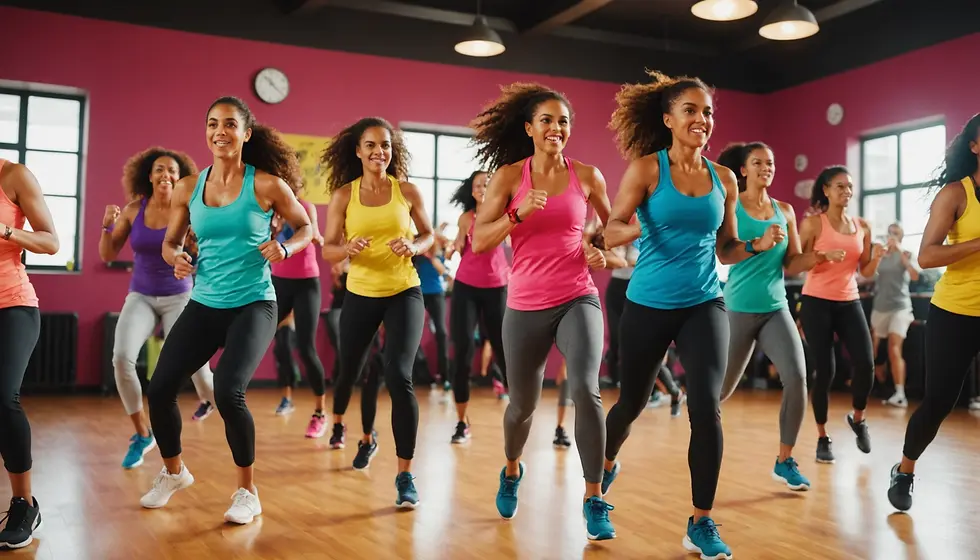Unlock Your Dance Potential with Essential Zumba Rhythms and Steps
- joloveszumba

- Jun 30
- 3 min read
Updated: Jul 1
Zumba is more than just a workout; it’s a celebration of movement, music, and expression. Born from Latin dance, Zumba and Zumba Gold blends smooth steps with exciting rhythms that transform sweating into joy. Whether you are an experienced dancer or a beginner eager to find your groove, mastering the basic rhythms can elevate your Zumba experience and enhance your enjoyment.
In this post, I dive into the core rhythms used in Zumba and Zumba Gold, pinpoint their cultural roots, and break down the fundamental steps for salsa, merengue, and cumbia. So lace up your trainers and get ready to unleash your creativity on the dance floor!

The Essence of Zumba Rhythms
Zumba is a dynamic fusion of musical styles and movements inspired by various dance genres.
While instructors may incorporate a variety of rhythms into their classes, some key ones to look for include:
Salsa
Merengue
Cumbia
Reggaeton
Bachata
Each rhythm adds its unique flair, providing variety and eclectic grooves in every class.
If you come to my Zumba or Zumba Gold classes you will also fine some Pop, Disco, Flamenco and Bollywood choreographies.
Countries Behind the Main Essential Zumba Rhythms
Understanding the origins of these rhythms deepens your appreciation and enjoyment. Here’s a closer look at where some of the main Zumba rhythms hail from:
Salsa: This rhythm comes from Cuba and the Caribbean. It's known for its fast-paced beats, often sitting around 180 BPM (beats per minute), and smooth movements.
Merengue: Originating from the Dominican Republic, merengue is celebrated for its easy 2/4 timing. It's playful and can burn up to 500 calories in one hour of dancing.
Cumbia: With roots in Colombia, cumbia mixes African, Indigenous, and Spanish influences. Its catchy rhythm allows participants to groove while enjoying a heart-healthy workout.
Reggaeton: Emerging from Puerto Rico, it blends Latin beats with hip-hop, with an average tempo of around 90-100 BPM, getting your heart rate up while you dance.
Bachata: Also from the Dominican Republic, this slower and romantic rhythm is a bit easier to learn. You can burn approximately 300 calories in a typical bachata class.
By dancing to these rhythms, you not only improve your fitness but also celebrate the diverse cultures that shaped them.
Learn the Basic Steps
If you're feeling nervous about going to your first class, or want to improve your technique, why not check out the Zumba Basic video which demonstrates some of the core steps.
Infusing Your Own Flare
One of the best parts of Zumba and Zumba Gold is that it invites personal flair. You can showcase your unique style. Here are some tips to make your Zumba experience your own:
Express Yourself: Feel free to incorporate hand movements or spins. Let your arms flow naturally with the rhythm.
Use Your Hips: Focus on your hip movements to enhance the expressiveness of your dancing.
Facial Expressions: Smile or laugh as you move! Your expressions can uplift the energy of your workout.
Incorporate Freestyle Moves: If you feel the beat, don’t hesitate to freestyle. Let the music guide your movements!
The Power of Dance
Zumba transcends simple choreography; it’s a community filled with joy and connection. The friendships you form on the dance floor can enhance your motivation to stay active.
Ultimately, remember to dance like no one is watching. Embrace your individuality and feel empowered as you move to lively global rhythms.
Final Thoughts
Unlocking your dance potential with essential Zumba rhythms and steps begins a joyful journey into fitness and expression. Each rhythm carries its unique history, enriching your experience in my dance fitness classes.
Regardless of your skill level, Zumba encourages exploration and personal growth. So step confidently into the world of salsa, merengue, cumbia and beyond! Let the music guide you, and above all, enjoy yourself!
Take the rhythms and steps you have learned, add your creativity, and remember:
Dance is not just movement; it’s a celebration of life!




Comments